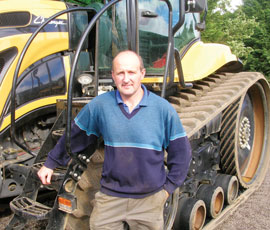Biosolids boost soil phosphate and raise yields

Improving soil phosphate through rotational use of biosolids has paid off for one Northamptonshire grower, as Paul Spackman discovers
Stephen Evans started using digested sewage sludge on his arable land eight years ago and is convinced the use of these biosolids has helped push up yields by almost a third.
His family farming and contracting business took over a 243ha block of arable ground in 2000 and he found that three decades of arable cropping without replacing lost nutrients had drained the area’s soil reserves.
The soil phosphate index was down to zero on much of this additional arable land, and yields were falling well short of their potential. But the move to biosolids in 2005 pushed the index up to three across all of Mr Evans’ 486ha farmed area.
“We started cropping the 600-acre block in 2000 and although we were soil testing and applying bagged fertiliser each year, we found it was only really replacing what the crop was using and not building the soil reserves,” he says.
“It was highlighted in some rape crops which used to turn a purple shade in winter which is indicative of phosphate deficiency,” Mr Evans added
This focus on soil nutrition combined with a more intensive fungicide strategy has improved yields by nearly a third in some areas.
“Winter wheat yields used to struggle to reach 7.5t/ha, but today can now average nearer 10t/ha in a normal year and up to 12.4t/ha. Even spring-sown wheat and barley averaged a pleasing 7.5-8t/ha this harvest,” he says.
“I farm with my parents and our business is geared towards high input and high output systems. The land wasn’t cropping as well as it should have been with the inputs we were using so we had to do something to get indices back to where they should be quickly,” he adds.
Nutribio digested sewage sludge was first used in 2005 with some of the poorest fields receiving applications every second year. The business was soon applying about 3,000t annually depending on rotation and indices, with the bulk going on after oilseed rape and before first wheat.
Application rates in the early days were around 25t/ha, but this has come down to 17-18t/ha with the development of a more concentrated higher dry matter “compost-like” product.
“Normally applying biosolids after rape means we have a decent window to get the spreaders in before drilling,” Mr Evans says.
“But things were a lot tighter this year due to the late ripening and we didn’t finish cutting rape until 1 September, which didn’t give much of a window for applying biosolids.”
However, this year four spreaders were ready to come in as soon as the rape ground was cleared and made short work of applying the 2,000t applied this autumn.
“One stockpile of 1,000t was done before lunch, so when you can work at that sort of rate it really helps the job along. It meant we weren’t held up with subsequent work and still finished drilling by 30 September,” he says.
Land is cultivated straight away with a Quivogne Tinemaster heavy disc/press to a depth of 75-100mm (3-4in) to ensure nutrients are kept within easy reach of young plants.
The nutrient value of biosolids can vary from year to year, but in some years phosphate content can be up to 400kg/ha, while there is a small nitrogen benefit and nitrogen rates have been cut by 15-20kg/ha.
Now that soil phosphate levels have been improved, Mr Evans says he can cut biosolids use and may give him scope to take a fertiliser “holiday” on some land.
Indeed, for the 2014-15 season, just 40-60ha will receive biosolids, about half the area treated this year.
His focus has now switched to boosting potash levels by incorporating green waste compost on some lighter land. Around 1,200t of compost has been applied for the first time this autumn and cultivated to 75-100mm.
“Green waste compost is more heavily loaded with potash, which the lighter land needs more than heavy clay,” says Mr Evans.
“In the early days of using digested sewage sludge Anglian Water was virtually giving it away at £1/t. That price has increased to nearer £7/t for us now, which includes soil sampling, delivery and spreading, but it still represents value for money.

